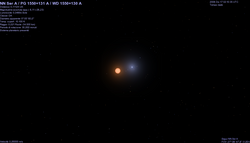| Observation data Epoch J2000 Equinox J2000 | |
|---|---|
| Constellation | Serpens |
| Right ascension | 15h 52m 56.12035s[1] |
| Declination | +12° 54′ 44.4293″[1] |
| Apparent magnitude (V) | +16.51[2] |
| Characteristics | |
| Spectral type | WD DAO1 / M4V[3] |
| Astrometry | |
| Proper motion (μ) | RA: −30.170±0.055 mas/yr[1] Dec.: −59.084±0.057 mas/yr[1] |
| Parallax (π) | 1.9438 ± 0.0662 mas[1] |
| Distance | 1,680 ± 60 ly (510 ± 20 pc) |
| Orbit[3] | |
| Period (P) | 0.13008017141(17) d |
| Semi-major axis (a) | 0.934 ± 0.009 R☉ |
| Eccentricity (e) | 0.0 |
| Inclination (i) | 89.6 ± 0.2° |
| Semi-amplitude (K1) (primary) | 62.3 ± 1.9 km/s |
| Semi-amplitude (K2) (secondary) | 301 ± 3 km/s |
| Details[3] | |
| White dwarf | |
| Mass | 0.535 ± 0.012 M☉ |
| Radius | 0.0211 ± 0.0002 R☉ |
| Surface gravity (log g) | 7.47 ± 0.01 cgs |
| Temperature | 57000 ± 3000 K |
| Red dwarf | |
| Mass | 0.111 ± 0.004 M☉ |
| Radius | 0.149 ± 0.002 R☉ |
| Other designations | |
NN Ser, PG 1550+131, WD 1550+130 | |
| Database references | |
| SIMBAD | data |
NN Serpentis (abbreviated NN Ser) is an eclipsing post-common envelope binary system approximately 1670 light-years away.[3] The system comprises an eclipsing white dwarf and red dwarf. The two stars orbit each other every 0.13 days.[3]
- ^ a b c d Cite error: The named reference
GaiaDR3was invoked but never defined (see the help page). - ^ Drake, A. J.; Graham, M. J.; Djorgovski, S. G.; Catelan, M.; Mahabal, A. A.; Torrealba, G.; García-Álvarez, D.; Donalek, C.; Prieto, J. L.; Williams, R.; Larson, S.; Christen Sen, E.; Belokurov, V.; Koposov, S. E.; Beshore, E.; Boattini, A.; Gibbs, A.; Hill, R.; Kowalski, R.; Johnson, J.; Shelly, F. (2014). "The Catalina Surveys Periodic Variable Star Catalog". The Astrophysical Journal Supplement Series. 213 (1): 9. arXiv:1405.4290. Bibcode:2014ApJS..213....9D. doi:10.1088/0067-0049/213/1/9. S2CID 119180446.
- ^ a b c d e Cite error: The named reference
Parsonswas invoked but never defined (see the help page).
